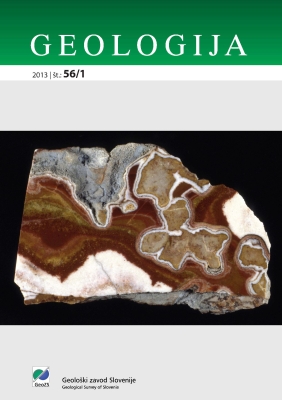The origin of emeralds embedded in archaeological artefacts in Slovenia
DOI:
https://doi.org/10.5474/geologija.2013.003Abstract
Roman gold jewellery, which was excavated in Ptuj (Poetovio) and consists of a necklace, earrings and a bracelet with embedded emeralds, is part of the Slovenian archaeological artefacts collections. Crystallographic characteristics, inclusions, luminous phenomena and geological characteristics were determined in order to establish the origin of the emeralds. Chemical composition of the emeralds was determined non-destructively using the methods of proton-induced X-rays and gamma rays (PIXE/PIGE). The results were compared with reference emeralds from Habachtal in Austria and with green beryls from the Ural Mts. Literature data for emeralds from Egypt and modern-day Afghanistan area were used to interpret the results. Specifically, these sites were known for emeralds being mined for jewellery in Roman times. It was assumed that emeralds from archaeological artefacts originated from Habachtal in Austria, given that this site was the nearest to the place where found. But the emeralds from the necklace and earrings in fact came from Egyptian deposits. The origin of emeralds from the bracelet could not have been determined absolutely reliably due to the lack of comparative materials; they may originate from a site in modern-day Afghanistan or from Egypt, but certainly not from the same site as the previously mentioned emeralds in the necklace and earrings.Downloads
How to Cite
Kržič, A., Šmit, Žiga, Fajfar, H., Dolenec, M., Činč Juhant, B., & Jeršek, M. (2013). The origin of emeralds embedded in archaeological artefacts in Slovenia. Geologija, 56(1), 29–45. https://doi.org/10.5474/geologija.2013.003
Issue
Section
Articles

